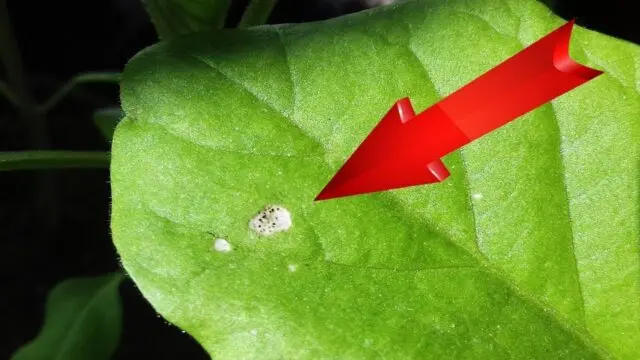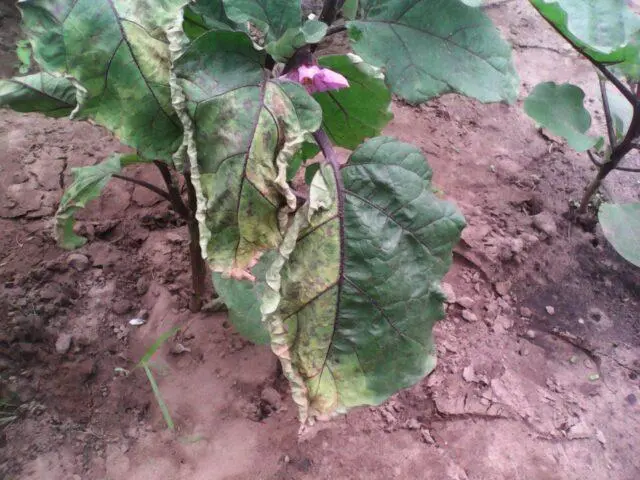Contents
Eggplant leaves turn white for a variety of reasons. Often they are associated with improper care, poor-quality soil. If the growing conditions are normal, but the leaves turn white, this is most likely the result of pests or diseases. The main causes and methods for their elimination are described in the article.
Why do eggplant leaves turn white?
Eggplant leaves turn white for various reasons. Plants are quite demanding, they need good lighting, stable watering, maintaining a certain level of humidity. It is equally important to provide regular top dressing and make fertile soil for planting or pre-fertilize the soil in the greenhouse. The main reasons why foliage becomes covered with white spots are described in the following sections.
Incorrect watering
Eggplants are quite demanding on constant moisture. Normally, water for seedlings should be given 3-4 times a week, watering it from a spray bottle, and then with a thin stream under the root. Adult bushes are watered twice a week, and in the heat – three times. If you do not follow these rules, the leaves will turn white, will wither and eventually fall off.
Another important point – watering should be regular and not too plentiful. For example, it is impossible to give the entire weekly norm at a time, and leave the plants without water for the rest of the days. It is better to water at least 4-5 days later. Also, the leaves may turn white due to too cold water. Therefore, it must first be defended to room temperature.
An excess of minerals
Eggplants need regular feeding, which is applied literally every 2-3 weeks. But do not think that the more fertilizer you give, the better for the plants. In fact, with an excess of minerals (potassium compounds, superphosphates, trace elements), the soil begins to saline.
As a result, the acidity index pH changes, due to which the root system absorbs nutrients much worse. Therefore, plants lag behind in development, the leaves turn white and become smaller, and noticeably fewer ovaries are formed.
Unsuitable soil
If light spots appear on the leaves of eggplant, the reasons may also be associated with poor-quality soil. The culture develops normally on chernozem, loamy soils with a loose structure and a neutral or slightly acid pH = 6-7.

Foliage may turn white due to irregular watering
If the soil is depleted, contains a lot of clay, the leaves may turn pale and then fall off. As a result, photosynthesis processes will be disrupted, the fruits will be small and not so tasty. Therefore, it is necessary to pre-compile or purchase a fertile mixture for growing seedlings.
A few months before transplanting seedlings into open ground or into a greenhouse, the soil is dug up and fertilizers are applied. If necessary, add sand, sawdust, so that the earth becomes less dense. Then the roots will get more air, which will ensure the normal growth of eggplant.
Unsuitable microclimate
Even if the soil is fertile, it is not enough to grow eggplant. The leaves of plants turn white and due to microclimate disturbances. The culture is quite demanding on temperature and humidity levels.
When growing seedlings, you need to maintain stable heat in the range of 25-27 degrees. Adult plants develop normally at a temperature of 22-28 degrees. A slight decrease is allowed at night, but not lower than +15. As for humidity, it should be approximately constant, but moderate – 70%.
In open ground, it is not always possible to create such conditions due to adverse weather. As a result, the leaves become covered with white spots. Therefore, in most regions, eggplant is cultivated in greenhouses or small greenhouses.
Excess lighting
Eggplants are demanding of light. Therefore, even at the stage of growing seedlings, it is necessary to install fitolamps. After transplanting into the greenhouse, it is better to shade the open ground seedlings a little. If the weather is too hot, too much sunlight can turn the leaves white. Therefore, gardeners usually install a canvas of light materials or protective screens.
Diseases and pests
White plaque on eggplant leaves also appears due to certain diseases or pests. Basically, the cause is associated with fungal infections, for example, Fusarium. It manifests itself with such symptoms:
- leaves become light;
- then they dry up and fall off;
- in the advanced stage, the entire bush dies.

signs of fusarium wilt
Also, the foliage turns white due to powdery mildew. The main symptom of the disease is the appearance of a powdery coating on the surface of leaves and stems. Affected bushes are best immediately planted from healthy ones.
As for pests, the main danger is spider mites. They are very small, so they are not visible to the eye. But you can determine their appearance by the characteristic thin cobweb covering the stems.
What to do if eggplant leaves turn white
When the foliage turns white, the first thing to do is determine the cause. If it is associated with improper care, it is enough to eliminate the influence of the harmful factor, for example, to normalize watering. If the cause is associated with infectious diseases, it is better to plant the affected plants, and treat the rest of the bushes with a fungicide.
White leaves on eggplant seedlings
On seedlings, foliage may turn white due to infertile soil. A suitable mixture can be purchased at the store or made with your own hands based on soddy soil, peat, sand and humus (2: 1: 1: 1). But if it is no longer possible to transplant seedlings, it is worth fertilizing. To do this, use complex compositions, for example, “Baikal” or “Ideal”.
It also happens that the soil is quite fertile, but the leaves still turn white. In this case, it is important to check the growing conditions – organize lighting, cover the seedlings with a film at the first stage, constantly ventilate and spray the soil from the sprayer.
White coating on eggplants in a greenhouse
If the eggplants turn white in the greenhouse, the reason is probably due to improper care. Plants should be watered every 4-5 days to keep the soil slightly moist. Too much water is just as bad as too little. To ensure constant moisture, plantings are recommended to be mulched with straw, hay, sawdust or other natural materials.
So that the leaves do not turn white, fertilizers are applied strictly according to the schedule and in the quantities indicated in the instructions. First, top dressing is given two weeks after transplantation, then at the flowering stage, after which – at the beginning of fruit formation, then during their ripening. It is recommended to use complex compositions, alternating them with organic matter, for example, mullein infusion 1:10.

Thanks to regular top dressing, the leaves will not turn white.
preventive measures
Cope with diseases, pests, eliminate the effects of sunburn or drought is not always easy. Sometimes the influence of negative factors is so strong that some of the bushes die. Therefore, it is recommended to follow certain preventive measures in order to prevent such problems. Experienced summer residents urge to pay attention to such tips:
- Etch the seeds before planting in a solution of potassium permanganate 1 g per 1 liter or a fungicide, for example, “Fundazol”.
- Disinfect both the soil and planting containers for seedlings.
- To prevent the leaves from turning white, regularly ventilate the room where the seedlings grow. Ventilate the greenhouse or greenhouse, especially after watering and in hot weather.
- Choose varieties that are adapted to the climatic conditions of the region, as well as resistant to diseases and pests. For example, you can consider the following varieties: Black handsome, Viola de Firenze, Epic F1 (hybrid), Gardener’s Dream, King of the North F1 (hybrid).
- So that the leaves are not white, observe the planting density, leaving a minimum distance of 35 cm between the bushes.
- After transplanting seedlings into the ground or into a greenhouse, carry out a single treatment with a fungicide, for example, Maxim, Tattu, Fundazol. This is a good measure to prevent powdery mildew and other infections that cause the leaves to turn white.
Conclusion
Eggplant leaves turn white, usually due to improper care. Plants are quite demanding, so you need to create suitable conditions for them at all stages – from seedlings to harvesting fruits. Usually eggplants are grown in a greenhouse, which makes it possible to adjust the microclimate. Thanks to this, the leaves will not turn white, it will be possible to get a good harvest.









